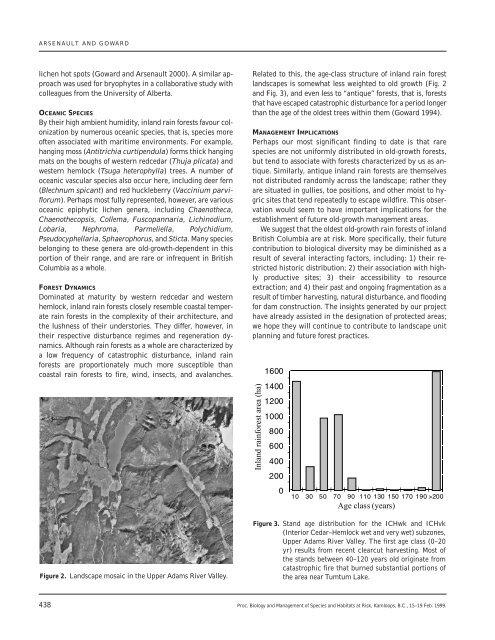Ecological Characteristics of Inland Rain Forests
Ecological Characteristics of Inland Rain Forests
Ecological Characteristics of Inland Rain Forests
Create successful ePaper yourself
Turn your PDF publications into a flip-book with our unique Google optimized e-Paper software.
ARSENAULT AND GOWARD<br />
lichen hot spots (Goward and Arsenault 2000). A similar approach<br />
was used for bryophytes in a collaborative study with<br />
colleagues from the University <strong>of</strong> Alberta.<br />
OCEANIC SPECIES<br />
By their high ambient humidity, inland rain forests favour colonization<br />
by numerous oceanic species, that is, species more<br />
<strong>of</strong>ten associated with maritime environments. For example,<br />
hanging moss (Antitrichia curtipendula) forms thick hanging<br />
mats on the boughs <strong>of</strong> western redcedar (Thuja plicata) and<br />
western hemlock (Tsuga heterophylla) trees. A number <strong>of</strong><br />
oceanic vascular species also occur here, including deer fern<br />
(Blechnum spicant) and red huckleberry (Vaccinium parviflorum).<br />
Perhaps most fully represented, however, are various<br />
oceanic epiphytic lichen genera, including Chaenotheca,<br />
Chaenothecopsis, Collema, Fuscopannaria, Lichinodium,<br />
Lobaria, Nephroma, Parmeliella, Polychidium,<br />
Pseudocyphellaria, Sphaerophorus, and Sticta. Many species<br />
belonging to these genera are old-growth-dependent in this<br />
portion <strong>of</strong> their range, and are rare or infrequent in British<br />
Columbia as a whole.<br />
FOREST DYNAMICS<br />
Dominated at maturity by western redcedar and western<br />
hemlock, inland rain forests closely resemble coastal temperate<br />
rain forests in the complexity <strong>of</strong> their architecture, and<br />
the lushness <strong>of</strong> their understories. They differ, however, in<br />
their respective disturbance regimes and regeneration dynamics.<br />
Although rain forests as a whole are characterized by<br />
a low frequency <strong>of</strong> catastrophic disturbance, inland rain<br />
forests are proportionately much more susceptible than<br />
coastal rain forests to fire, wind, insects, and avalanches.<br />
Related to this, the age-class structure <strong>of</strong> inland rain forest<br />
landscapes is somewhat less weighted to old growth (Fig. 2<br />
and Fig. 3), and even less to “antique” forests, that is, forests<br />
that have escaped catastrophic disturbance for a period longer<br />
than the age <strong>of</strong> the oldest trees within them (Goward 1994).<br />
MANAGEMENT IMPLICATIONS<br />
Perhaps our most significant finding to date is that rare<br />
species are not uniformly distributed in old-growth forests,<br />
but tend to associate with forests characterized by us as antique.<br />
Similarly, antique inland rain forests are themselves<br />
not distributed randomly across the landscape; rather they<br />
are situated in gullies, toe positions, and other moist to hygric<br />
sites that tend repeatedly to escape wildfire. This observation<br />
would seem to have important implications for the<br />
establishment <strong>of</strong> future old-growth management areas.<br />
We suggest that the oldest old-growth rain forests <strong>of</strong> inland<br />
British Columbia are at risk. More specifically, their future<br />
contribution to biological diversity may be diminished as a<br />
result <strong>of</strong> several interacting factors, including: 1) their restricted<br />
historic distribution; 2) their association with highly<br />
productive sites; 3) their accessibility to resource<br />
extraction; and 4) their past and ongoing fragmentation as a<br />
result <strong>of</strong> timber harvesting, natural disturbance, and flooding<br />
for dam construction. The insights generated by our project<br />
have already assisted in the designation <strong>of</strong> protected areas;<br />
we hope they will continue to contribute to landscape unit<br />
planning and future forest practices.<br />
Figure 2. Landscape mosaic in the Upper Adams River Valley.<br />
Figure 3. Stand age distribution for the ICHwk and ICHvk<br />
(Interior Cedar–Hemlock wet and very wet) subzones,<br />
Upper Adams River Valley. The first age class (0–20<br />
yr) results from recent clearcut harvesting. Most <strong>of</strong><br />
the stands between 40–120 years old originate from<br />
catastrophic fire that burned substantial portions <strong>of</strong><br />
the area near Tumtum Lake.<br />
438 Proc. Biology and Management <strong>of</strong> Species and Habitats at Risk, Kamloops, B.C., 15–19 Feb. 1999.


